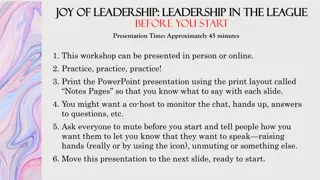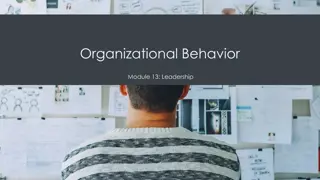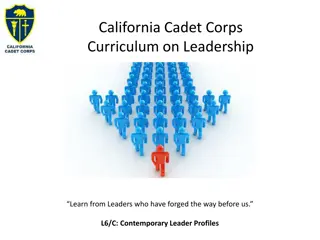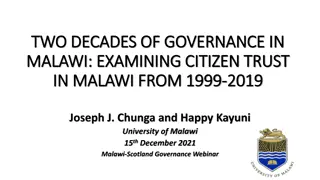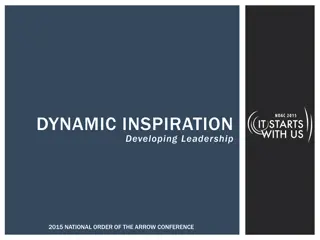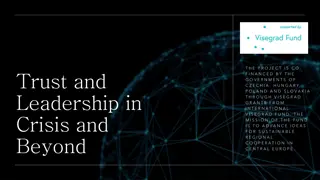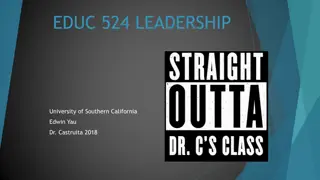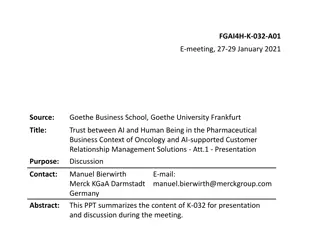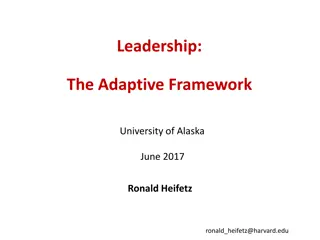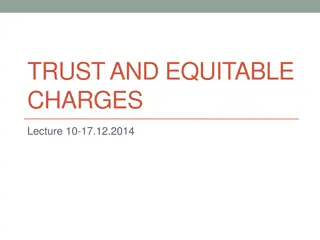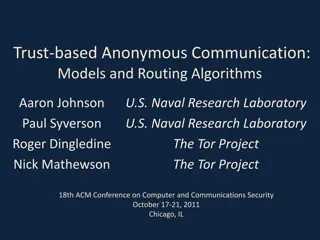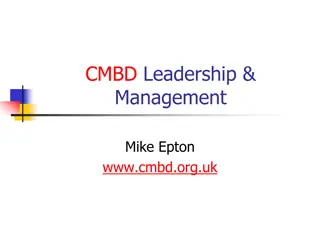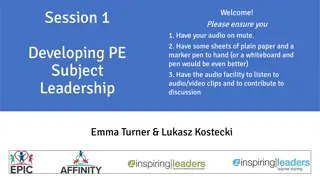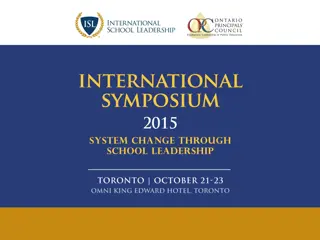Understanding Trust in Contemporary Leadership
Trust is the foundation of effective leadership, comprising elements like integrity, competence, consistency, loyalty, and openness. Trust plays a crucial role in leadership, impacting team performance and cooperation. Different types of trust - deterrence-based, knowledge-based, and identification-based - influence organizational relationships in various ways. Building trust involves establishing familiarity, reducing risk, and fostering positive expectations within a team.
Download Presentation

Please find below an Image/Link to download the presentation.
The content on the website is provided AS IS for your information and personal use only. It may not be sold, licensed, or shared on other websites without obtaining consent from the author. Download presentation by click this link. If you encounter any issues during the download, it is possible that the publisher has removed the file from their server.
E N D
Presentation Transcript
Trust: The Foundation of Leadership A. What is Trust? 1. Trust is a positive expectation that another will not through words, actions, or decisions act opportunistically. 2. The two most important elements of our definition are that it implies familiarity and risk. Positive expectation assumes knowledge and familiarity about the other party. Opportunistically refers to the inherent risk and vulnerability in any trusting relationship. 3. Trust is not taking risk per se; rather it is a willingness to take risk. 4. What are the key dimensions that underlie the concept of trust? Recent evidence has identified five: a. Integrity b. Competence c. Consistency d. Loyalty e. Openness Integrity refers to honesty and truthfulness. Of all five dimensions, this one seems to be most critical when someone assesses another s trustworthiness. Competence encompasses an individual s technical and interpersonal knowledge and skills.
B. Trust and Leadership 1. Trust is a primary attribute associated with leadership. When trust is broken, it can have serious adverse effects on a group s performance. 2. It is evident that it is impossible to lead people who do not trust you. Trust and trust-worthiness modulate the leader s access to knowledge and cooperation. 3. When followers trust a leader, they are willing to be vulnerable to the leader s actions, confident that their rights and interests will not be abused. 4. Honesty consistently ranks at the top of most people s list of characteristics they admire in their leaders. 5. Reengineering, downsizing, and the increased use of temporary employees have undermined a lot of employees trust in management
C. Three Types of Trust 1. There are three types of trust in organizational relationships: deterrence-based, knowledge-based, and identification-based. 2. Deterrence-Based Trust: The most fragile relationships are contained in deterrence-based trust. One violation or inconsistency can destroy the relationship. This form of trust is based on fear of reprisal if the trust is violated. Deterrence-based trust will work only to the degree that punishment is possible, consequences are clear, and the punishment is actually imposed if the trust is violated. An example of deterrence-based trust is a new manager-employee relationship. As an employee, you typically trust a new boss even though there is little experience to base that trust on. The bond that creates this trust lies in the authority held by the boss and the punishment he or she can impose if you fail to fulfill your job related obligations. 3. Knowledge-Based Trust: Most organizational relationships are rooted in knowledge-based trust. It exists when you have adequate information about someone to understand them well enough to be able to accurately predict their behavior. Knowledge of the other party and predictability of his or her behavior replaces the contracts, penalties, and legal arrangements more typical of deterrence-based trust. Predictability enhances trust even if the other is predictably untrustworthy because the ways that the other will violate the trust can be predicted! The more communication and regular interaction you have with someone else, the more this form of trust can be developed and depended upon. Interestingly, at the knowledge-based level, trust is not necessarily broken by inconsistent behavior. If you believe you can adequately explain or understand another s apparent violation, you can accept it, forgive the person, and move on in the relationship. 4. Identification-Based Trust: The highest level of trust is achieved when there is an emotional connection between the parties. This is called identification-based trust.
Charismatic Leadership How do charismatic leaders actually influence followers? The evidence suggests a four-step process: The leader first articulates an appealing vision. This vision provides a sense of continuity for followers by linking the present with a better future for the organization. The leader then communicates high performance expectations and expresses confidence that followers can attain. Next, the leader conveys through words and actions a new set of values and, by his or her behavior, sets an example for followers to imitate. Finally, the charismatic leader makes self-sacrifices and engages in unconventional behavior to demonstrate courage and convictions about the vision.
C. Transformational Leadership 1. Most of the leadership theories presented in the previous chapters for instance, the Ohio State studies, Fiedler s model, path-goal theory, and the leader participation model have concerned transactional leaders. 2. These kinds of leaders guide or motivate their followers in the direction of established goals by clarifying role and task requirements. 3. Transformational leaders inspire followers to transcend their own self-interests for the good of the organization. 4. They change followers awareness of issues by helping them to look at old problems in new ways; and they are able to excite, arouse, and inspire followers to put out extra effort to achieve group goals. 5. Transformational leadership is built on top of transactional leadership it produces levels of follower effort and performance that go beyond what would occur with a transactional approach alone. 6. Evidence indicates that transformational leadership is more strongly correlated with lower turnover rates, higher productivity, and higher employee satisfaction.
Visionary Leadership Notes: 1. Visionary leadership is the ability to create and articulate a realistic, credible, attractive vision of the future for an organization or organizational unit, that grows out of and improves upon the present. 2. This vision is so energizing that it in effect jump-starts the future by calling forth the skills, talents, and resources to make it happen. 3. Vision differs from other forms of direction setting in several ways: A vision has clear and compelling imagery that offers an innovative way to improve, which recognizes and draws on traditions, and connects to actions that people can take to realize change. Vision taps people s emotions and energy. Properly articulated, a vision creates the enthusiasm that people have for sporting events and other leisure-time activities, bringing this energy and commitment to the workplace. 4. Qualities of a Vision: The key properties of a vision seem to be inspirational possibilities that are value centered, realizable, with superior imagery and articulation. Desirable visions fit the times and circumstances and reflect the uniqueness of the organization. People in the organization must also believe that the vision is attainable. It should be perceived as challenging yet do-able. Visions that have clear articulation and powerful imagery are more easily grasped and accepted. 5. Qualities of a Visionary Leader: Once the vision is identified, these leaders appear to have three qualities that are related to effectiveness in their visionary roles:
Emotional Intelligence and Leadership Effectiveness IQ and technical skills are threshold capabilities. They are necessary, but not sufficient requirements for leadership. It is the possession of the five components of emotional intelligence self-awareness, self- management, self-motivation, empathy, and social skills that allows an individual to become a star performer. Without EI, a person can have outstanding training, a highly analytical mind, a long-term vision, and an endless supply of terrific ideas, but still not make a great leader. When star performers were compared with average ones in senior management positions, nearly 90 percent of the difference in their effectiveness was attributable to EI factors rather than basic intelligence


